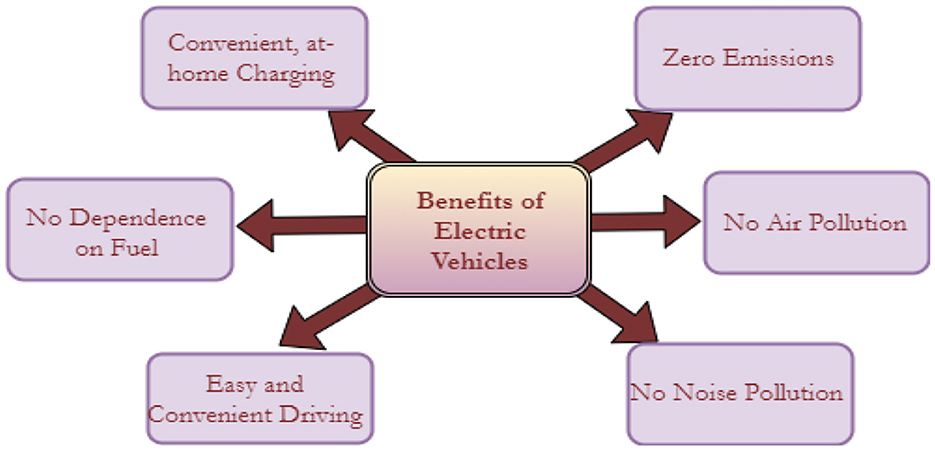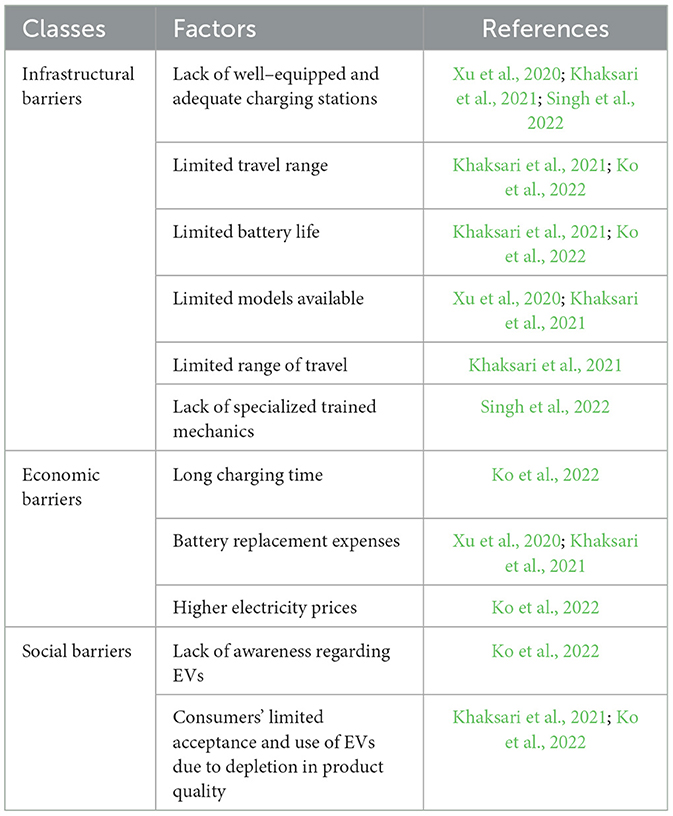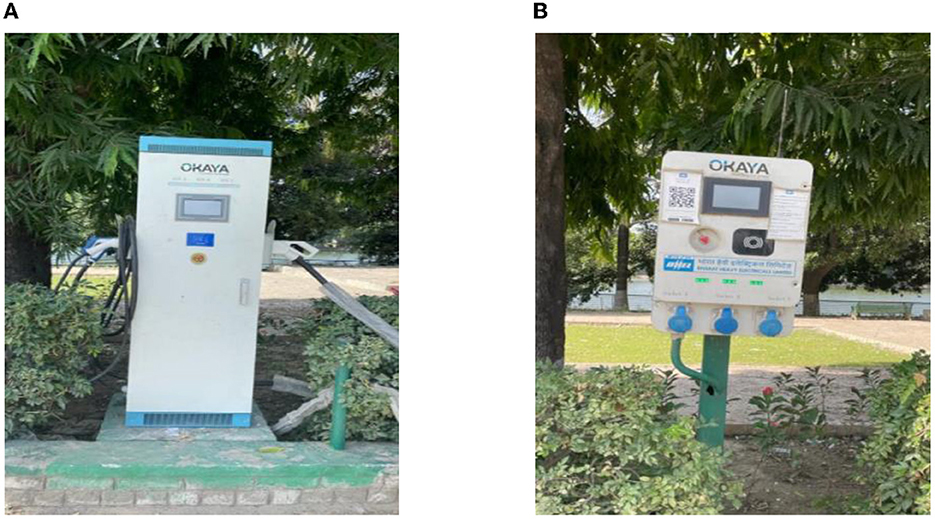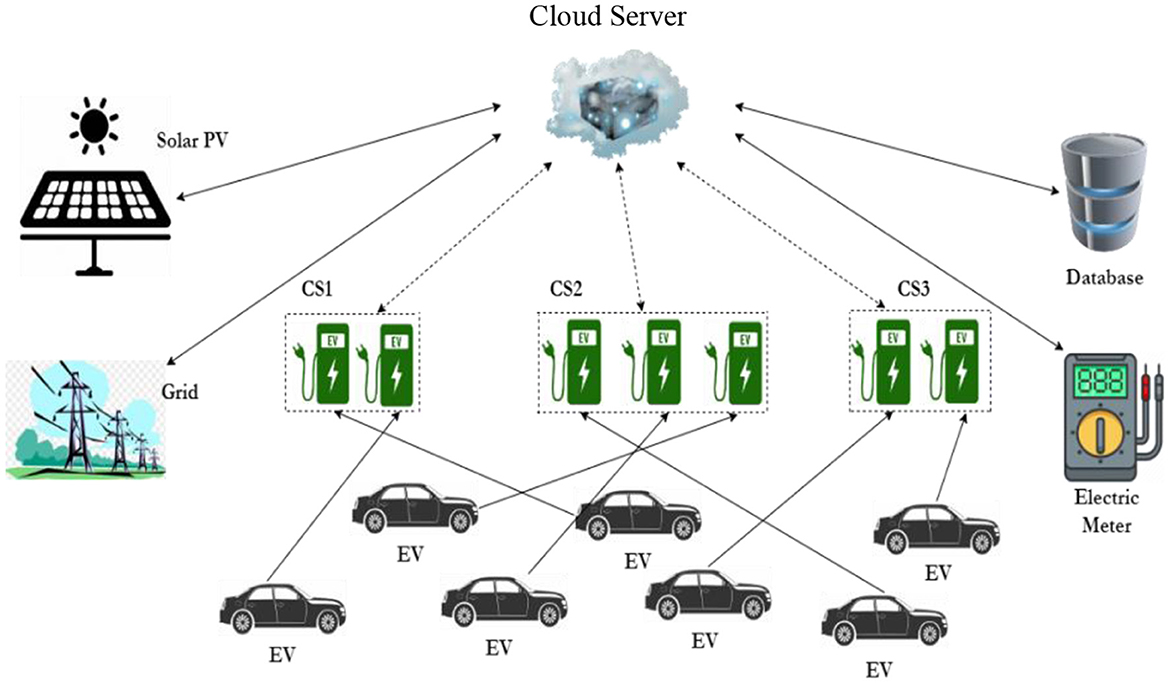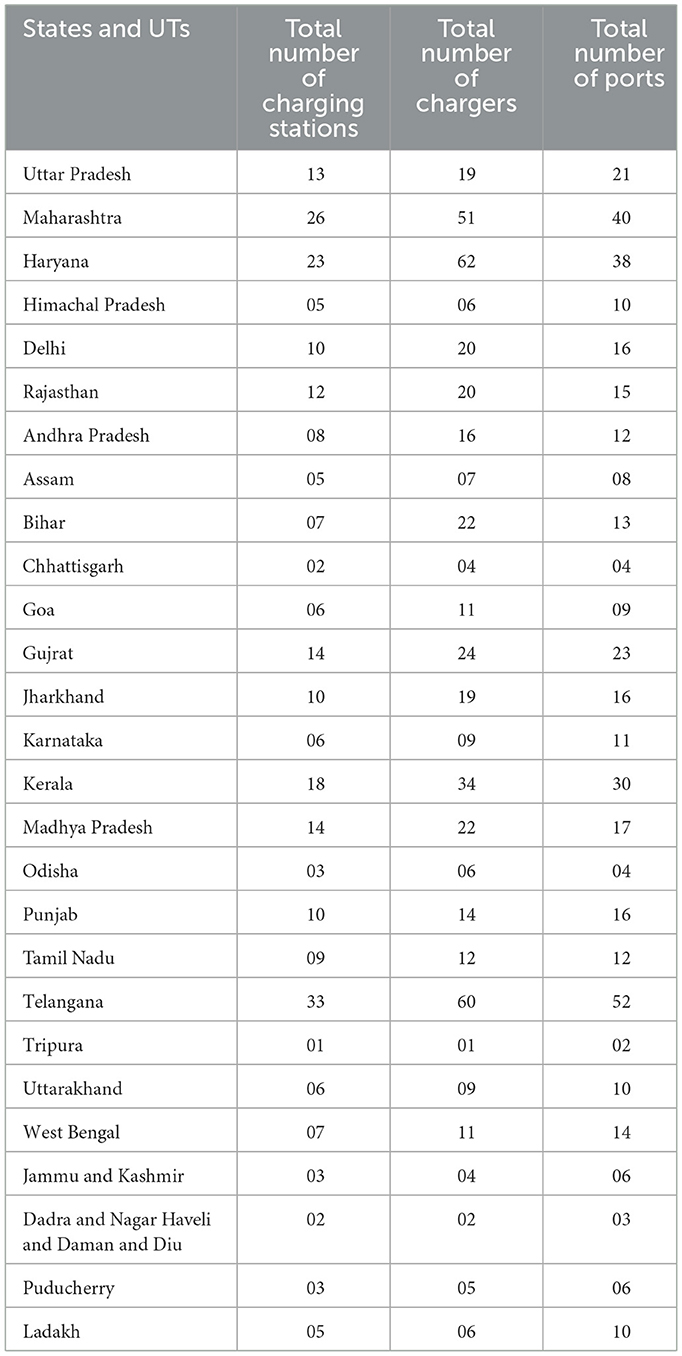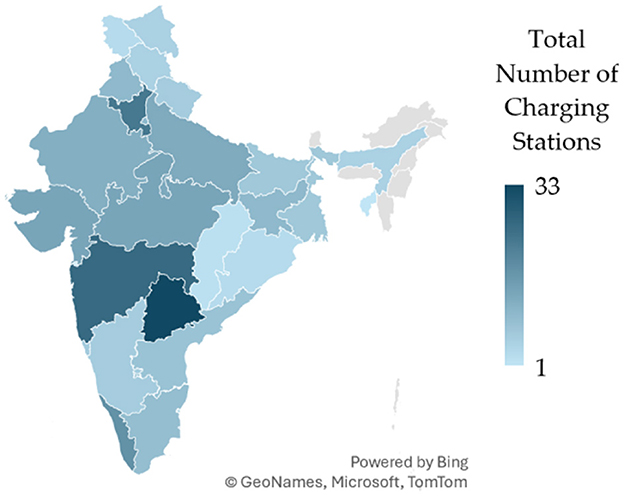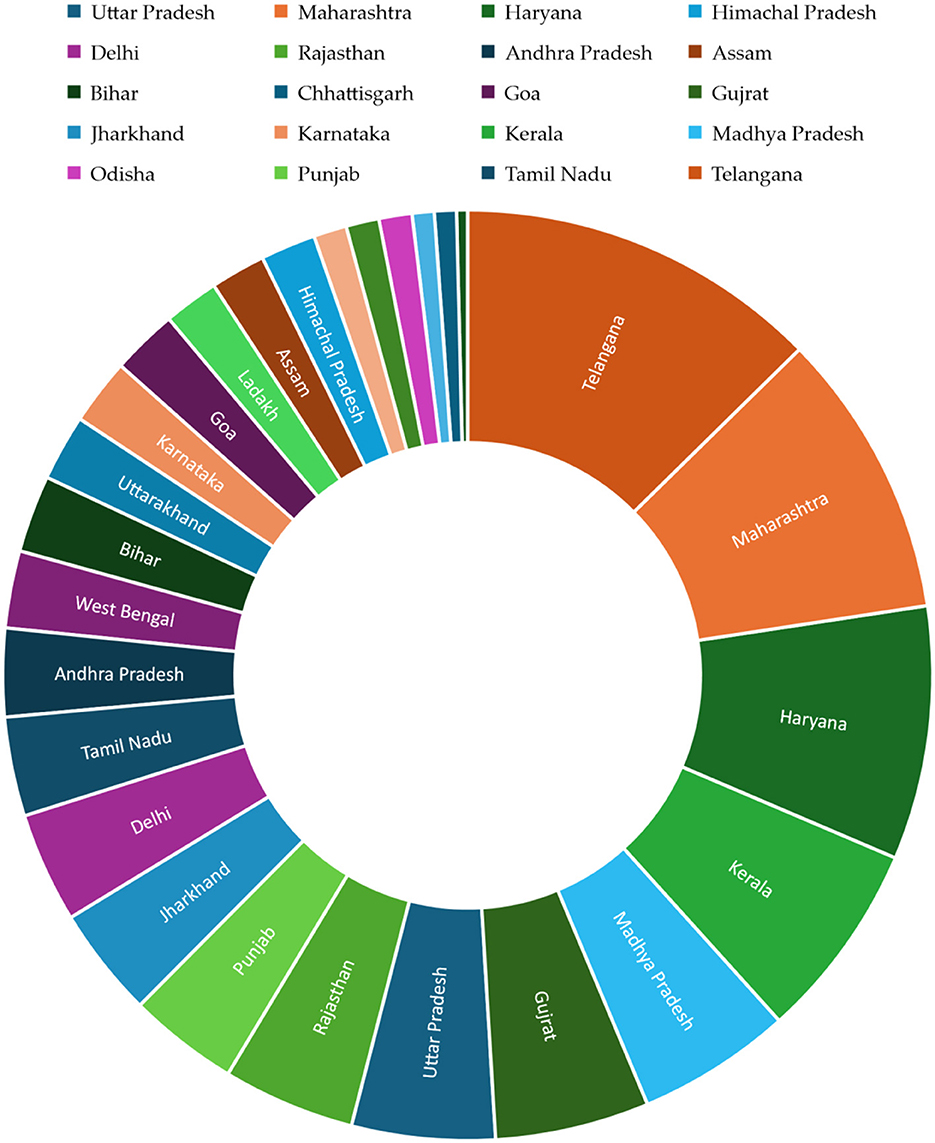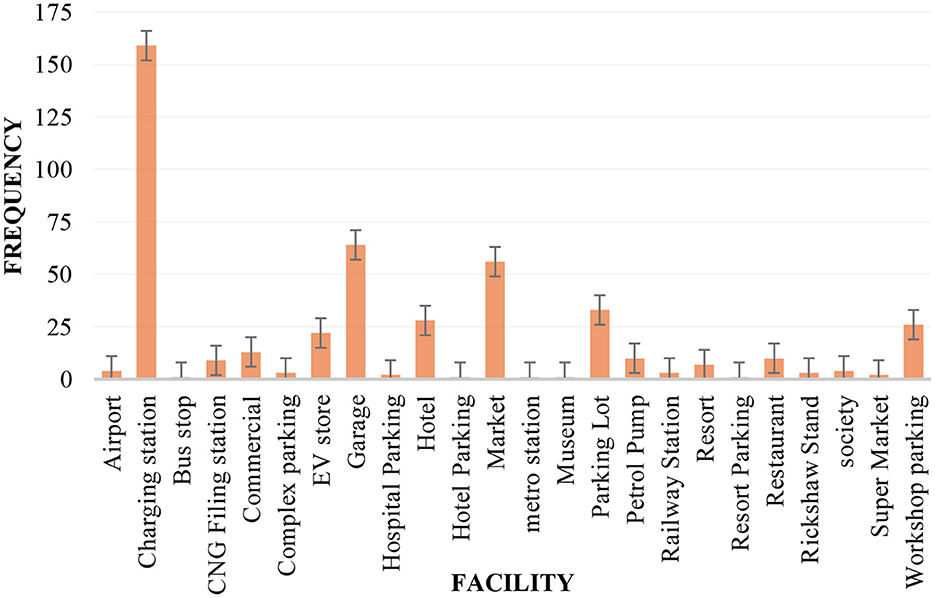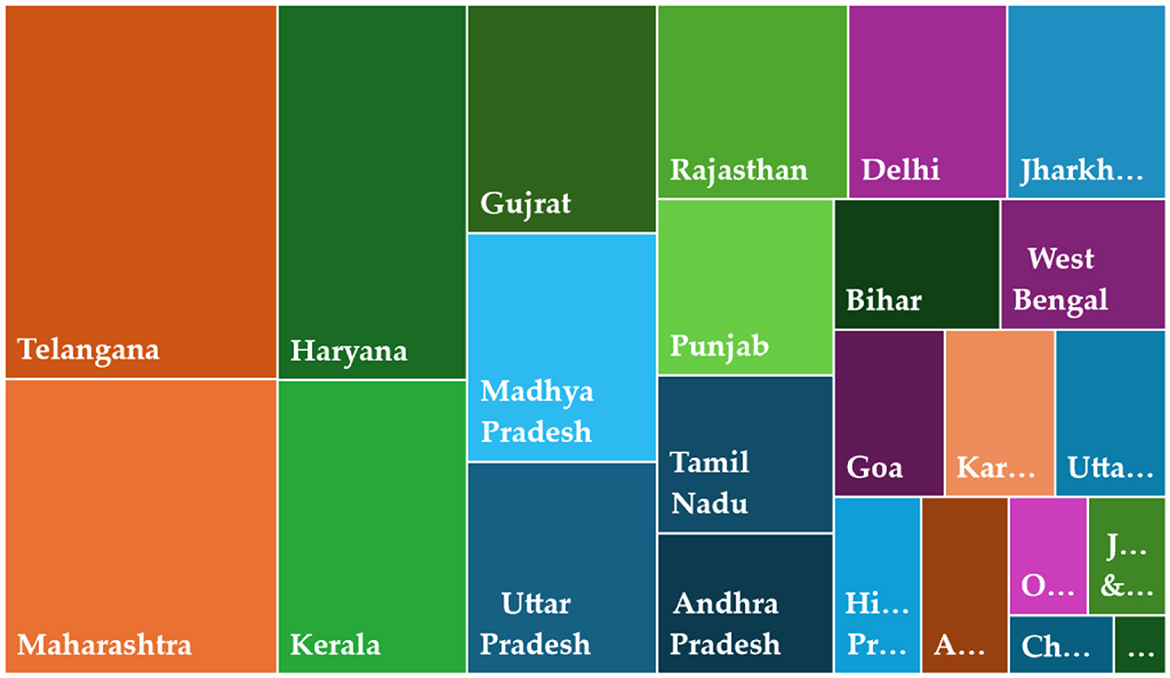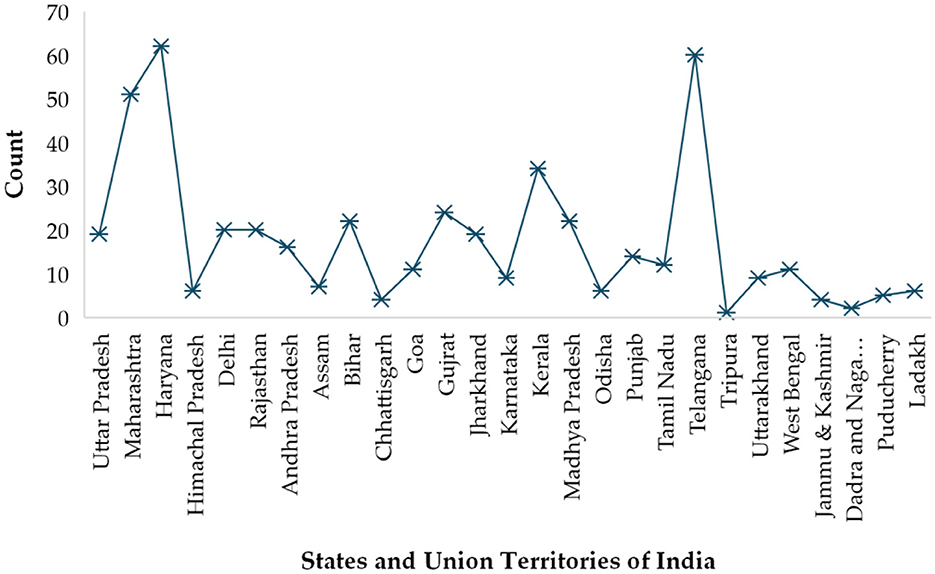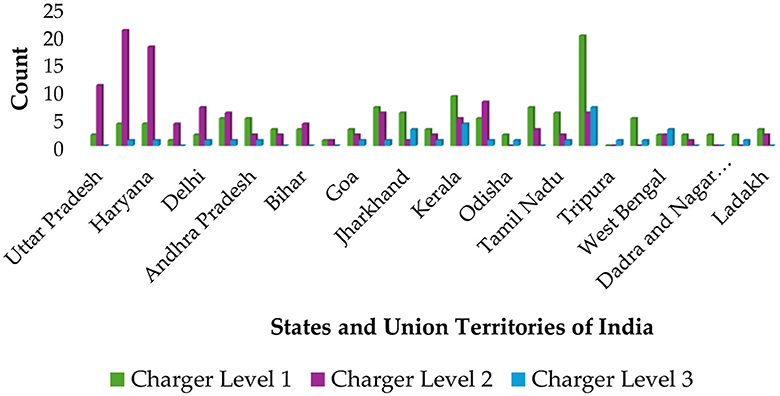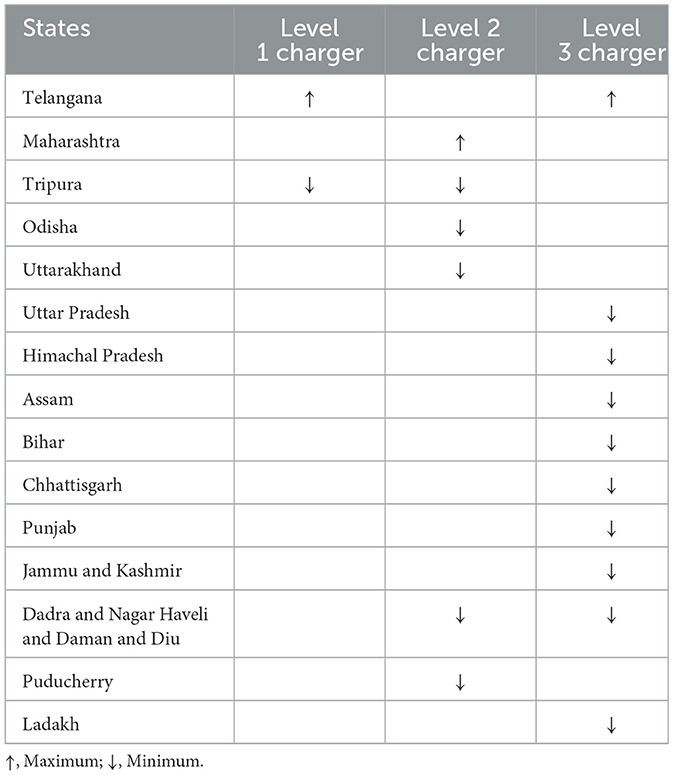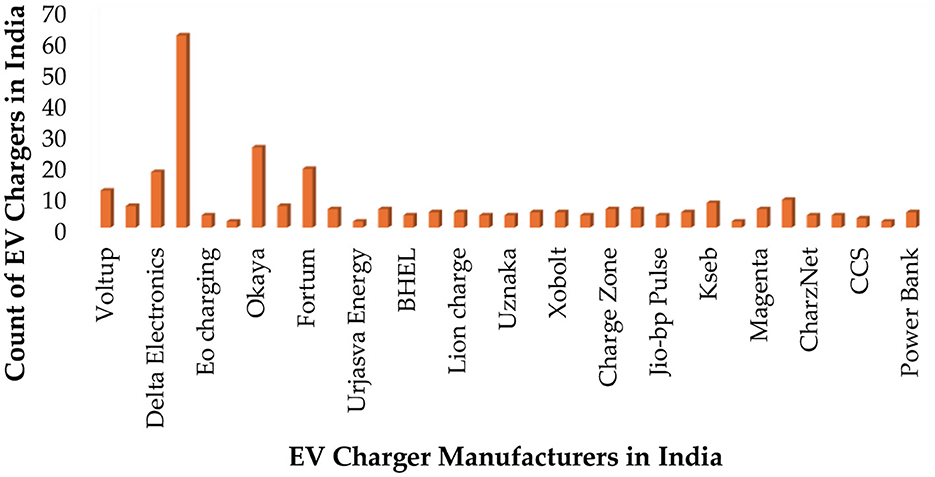- 1Department of Management Information Systems, College of Business Administration, King Faisal University, Al Ahsa, Saudi Arabia
- 2Chitkara University Institute of Engineering and Technology, Chitkara University, Rajpura, India
- 3Department of CSE AI, KIET Group of Institutions, Ghaziabad, India
- 4Department of Software Engineering, Faculty of Engineering and Technology, University of Sindh, Jamshoro, Pakistan
An Electric Vehicle (EV) charger or Electric Vehicle Supply Equipment (EVSE) is a piece of equipment that supplies electrical power for charging plug–in electric vehicles. Although batteries can only be charged with Direct Current (DC) power, most electric vehicles have an onboard Alternative Current AC—to—DC converter and most fully electric cars can accept both AC and DC power. The adoption of EVs can bring about significant relief in noise pollution and also environmental pollution if the required electricity is generated using renewable sources. DC charging stations of various levels are commonly equipped with multiple ports of various levels to be able to charge a wide variety of EVs. EVSEs are found at various facilities such as street–side or retail shopping centers, government facilities, and other parking areas. To ensure a sustainable environment by reducing the carbon emissions from vehicles, the use of EVs needs to be promoted. The need for having Electric Vehicle Charging Stations (EVCS) in any region depends upon the demand and cluster density of EVs in that region and is a major factor in the process of promoting the use of EVs and facilitating sustainable tourism using cleaner fuels. The authors of this study have located the various types and numbers of EVSEs throughout all the states and union territories of India, showing the emerging use of EVs so that EV users can conveniently locate charging stations and plan their routes accordingly. Furthermore, other citizens may be encouraged to own and use EVs for better environmental sustainability.
1 Introduction
The advent of electric vehicles (EVs) has brought about a game-changing scenario in attaining sustainability in the process of urbanization across the globe. In this context, EVs use cleaner fuel to ensure sustainability only if charged from renewable energy generation sources, thus causing minimum air and noise pollution. Unlike Internal Combustion Engine (ICE) vehicles, EVs are found to cause no environmental degradation in connection with de-carbonization due to reduced CO2 emissions, which may be termed the biggest advantage of using EVs. Therefore, the use of EVs needs to be motivated and enhanced further. Although EVs are one of the emerging needs of the modern day, the adoption of EVs nationwide in many of the developing nations is still lagging due to various reasons. One of the most important reasons is the lack of an adequate number of EVEs throughout those countries. Electricity acts as the fuel for EVs and alternative renewable sources of electricity must be used for further facilitation of EVSE installation and EV use. The use of renewable sources of power generation such as solar PV systems and pumps-used-as-turbines (PATs) to charge EV batteries is studied in Balacco et al. (2021) and Singh et al. (2022). Wireless charging of EVs is an emerging trend that researchers have put forth where charging is done by inductive or capacitive coupling, which is yet to be started in India. Climatic changes, continuously depleting fossil fuel reserves along air and noise pollution are a few of the continually evolving issues that act as motivations to researchers along with the most important ones like policymakers, investors, operators, etc. across all geographic locations to find newer, better, and more effective solutions. Another very practically applicable and economical way of recharging EV batteries is the Battery Swapping Station (BSS) (Savio Abraham et al., 2021). The idea of a Mobile Charging Station (MoCS) has been incorporated and a system with BEV to BEV charging algorithm has only been developed conceptually (Chakraborty et al., 2022) but it failed due to many reasons such as financial causes in Denmark and Israel. Lithium-ion–Ion Batteries (LIBs) are the most widely used batteries in EVs about the fact that they currently are deemed to provide the best power performance and may either be connected in series or parallel. However, they may explode when overcharged and may have a considerably reduced battery life when undercharged. The resulting inconsistency caused by manufacturing issues and usage causes a reduced overall charging capacity (Balacco et al., 2021; Lei et al., 2022).
Regardless of many limitations, there are numerous benefits of EVs over traditional ICE vehicles as depicted in Figure 1.
In Macioszek and Sierpiński (2020), the authors have focused on the EV charging facilities in Poland, their locations, websites, characteristics, etc. Macioszek (2021) have mentioned another vital aspect that promotes EV use in any nation, which is the government incentive policies. In many countries where EV purchase and use is in its initial stage, government incentives prove to be one of the most effective promoting measures for the purchase and sale of EVs in nations like Poland.
EVs can be charged at home at the users' own time and convenience (Xu et al., 2020; Chakraborty et al., 2022). The dependency on any kind of fuel is eliminated in EVs which in turn causes zero emission (Suomalainen and Colet, 2019), thus resulting in zero air and noise pollution (El-Fedany et al., 2019). Environmental cleanliness is ensured and maintained with the replacement of EVs with traditional ICE vehicles. Apart from all the benefits, EV manufacturers have ensured easy driving mechanisms for the owners of EVs (Jiang and Zhen, 2019).
The purpose behind choosing charging facilities for electric vehicles as the research domain here is predominantly the sustainability issue that needs to be addressed for the rapid urbanization of countries. A vast section of the rural population is seen to migrate to the urban society and lifestyle, which in turn causes an enormous number of vehicles plying on the roads. This is found to be one of the major causes of the alarmingly increased CO2 emission in the atmosphere, the other factors being electricity and heat (Balacco et al., 2021). The majority of the public, commercial, and personal transportation in India run on Internal Combustion Engines (ICE), which has on itself the heaviest burden of causing climate change and greenhouse emissions while on the run (Singh et al., 2022).
The plot in Figure 2 is a screenshot from “Google Trends”. This shows the trend of electric vehicles for the past 5 years, in India, i.e., from 2018. It can be seen that the trend of the use of electric vehicles is increasing at a steady pace. Thus, to cope with the increasing purchase and use of EVs in India, the availability of EV charging stations is also gaining rapid importance.
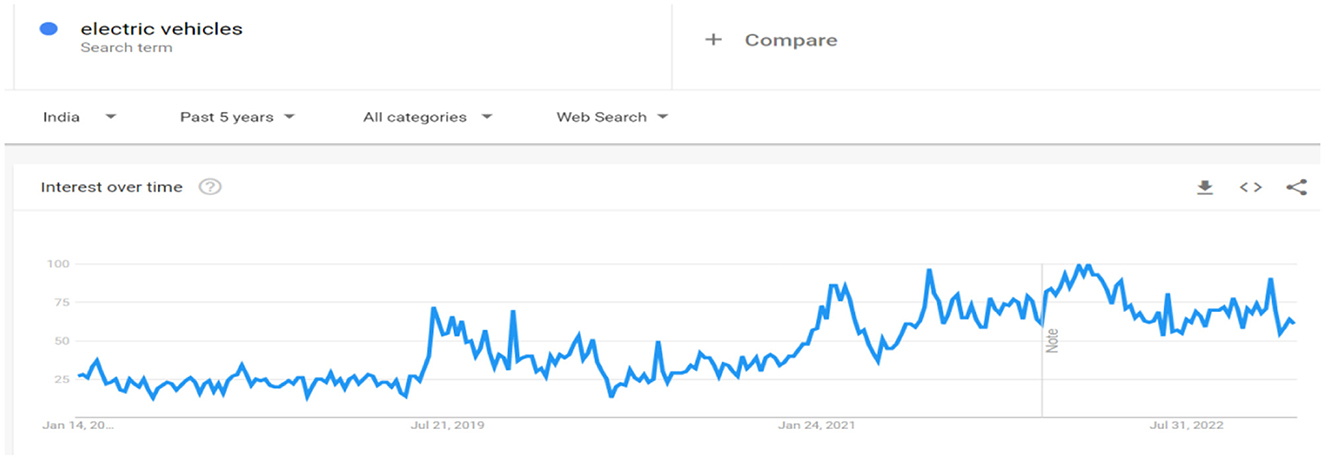
Figure 2. Trend of use of EVs in India since 2018 (Google Trends, 2023).
The Google data in Figure 2 is a screenshot of the Google Trends website. The authors have tried to understand the trend of purchase and use of EVs in India in the past 5 years. The plot is called “Interest over time”. The authors have used this as a means of motivation to work on the review study regarding the EV charging stations in India, as with the continuous increase in the trend of EV use in the country the necessity of availability of EVCS in the country.
The concept of generating energy is different from the concept of distributing it. Energy generation is dependent on several factors like resource availability, expenditure incurred, manpower availability, and other environmental, social, and legal factors, whereas the distribution of energy is dependent on a different set of factors like environmental footprint, location, expenses, reliability, etc. The selection of generation and distribution of energy is affected by the requirement of utility. Although these are different methods, their balanced implementation goes hand in hand. Effective utilization of energy is equally important as the effective generation of energy but an efficient mix of these two methods is required to ensure proper balance and sustainability.
Figure 3 shows a plotted representation of the number of all EVs in India since 2018. The number of EVs are found to be steadily rising since 2018 but a steep rise in its use in India is seen from the year 2021.
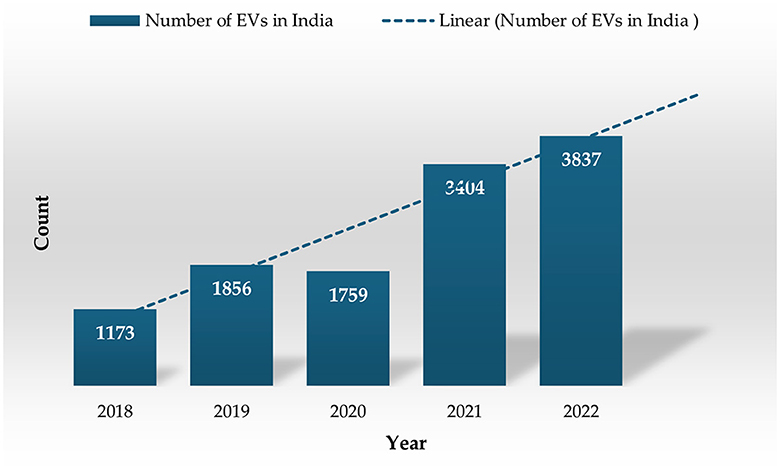
Figure 3. Number of electric vehicles in India since 2018 (Macioszek and Sierpiński, 2020).
The motivation to enhance the use of EVs in many developing countries also arose from various gaps identified in the smooth implementation of electric vehicles, from the extensive background study carried out. The lack of adequate charging infrastructure is the biggest barrier preventing the full–fledged development of EVs. Apart from analyzing the optimal locations for their placements by the government, their infrastructural uptake is a less explored domain as of now (Aswani et al., 2018). There is a notable shortage in the number of EV charging stations in India, which directly relates to the magnitude of the future EV fleet on highways, the efficiency of wireless systems, and also to the longevity and expenses of charging lanes (Vaidya and Mouftah, 2020). Some of the other major limitations of EVs are limited active battery duration, a significantly long charging time apart from the rapid charging ones, and insufficient dedicated parking spaces or grid energy availability. One of the many possible solutions to this problem is planning the EV journey to optimize the trip (Rienzo et al., 2022).
There are three basic types of EV chargers:
• Level 1 or slow type.
• Level 2 or normal type.
• Level 3 or fast type.
Level 1 charger is called a slow charger because it takes around 12–20 h to fully charge from empty, whereas Level 2 or normal charger takes only 4–7 h and Level 3 or fast charger takes maximum of 1 h to fully charge a battery from empty. Level 1 and Level 2 chargers work on AC current whereas Level 3 chargers work on DC current. The voltage consumption of the Level 3 fast chargers is the maximum i.e. 480 V as compared to that of Levels 1, and 2, i.e., 120 V, and 240 V respectively. J1772 type of connector is compatible for the slow and normal chargers, whereas CCS1 type of charger is used in fast chargers (Jiang and Zhen, 2019; Vaidya and Mouftah, 2020; Barragán-Moreno et al., 2022; Rienzo et al., 2022).
Some research questions are identified to work toward the process of this research. The following research questions are formulated:
RQ. 1: What is the total number of EV charging stations installed throughout India?
RQ. 2: Which charging facility has the maximum number of EV chargers in India?
RQ. 3: Which state or union territory of India has the maximum and minimum number of EV charging stations?
RQ. 4: Which Indian state or union territory has the highest number of Level 1, 2, and 3 types of EV chargers?
RQ. 5: Which is the leading EV charger manufacturer in India?
To facilitate the use of EVs, the availability of charging stations evenly throughout the country is of utmost importance in cases where the charging stations are not demand-responsive. A dataset is created for all the EVSE available throughout all the Indian states and Union Territories. Various fields are considered regarding the address, zip code, charger types, charging facility, number of ports, charger type, charging fees, etc. which gives detailed knowledge about each of the EVS across the nation. This dataset is then analyzed to obtain the answers to the research questions formulated.
The chosen research domain is expected to contribute to explaining all the charger types according to their levels. A dataset is created for all the states and union territories of India where the specifications are States and Union Territories, Address of the Charging Facility, Zip Code, Facility, Charger Location, Number of Chargers, Number of Ports, Charger Level, and Manufacturer Name. Based on the generated dataset, a track is kept of all the existing and functional EVSEs of India. The number of charging stations in each state and union territory, the number of charging stations available in each type of facility, categorization of charging stations according to the locations of the maximum and minimum number of charging stations in India, states where there is a maximum number of levels 1, 2, and 3 types of EV chargers. This information will be helpful to all the EV users to obtain an overview of the charging facilities available and also will act as a basis for the further planning and installation of EVSE. Which in turn will promote the use of EVs further. Thus, ensuring a two–way benefit to the environment along with facilitating urbanization.
The first empirical section of the research work consists of the introduction to EVs, the importance of EVs, their necessity, the advantages of EVs over traditional ICE vehicles, and the increasing trend of EV use in India. An extensive literature review including various types of EVs and their specifications, basic components of a PHEV and a BEV, various types of EV charging methods with their advantages and disadvantages, and various factors restricting EV use supported by background literature is mentioned in the second section. The third section comprises the materials and methods used in this study. The description of various charger levels is given along with the compressed representation of the original dataset is presented for a clearer understanding. The results and discussions are covered in the fourth section where the number of EVSE in each state and union territory of India, the number of charging stations in each type of charging facility, the number of EV chargers in each state and union territory of India, the number of types 1, 2, and 3 chargers in each state and union territory of India, and the most popular EVSE manufacturers in India. The fifth section concludes the study.
2 Literature review
Optimizing the charging schedule of the EVs by integrating the Energy Storage System (ESS) and Photovoltaic (PV) System in the respective parking areas has proved to be a lot helpful regarding limited parking areas (Suomalainen and Colet, 2019; Xu et al., 2020) by planning a schedule for the EVs for their charging slot. Design and implementation of a smart EV charging management system utilizing a charging strategy that includes effective reservation management and efficient slot allocation of CSS is found in El-Fedany et al. (2019). Battery Management System (BMS) and State of Health (SoH) estimation is one of the parameters that have a major role to play in the battery capacity and life of EVs, out of which an accurate SoC estimation of a battery can be used to ensure safety and enhanced battery life (El-Fedany et al., 2019; Jiang and Zhen, 2019; Google Trends, 2023). Apart from the battery health, the expenses incurred in installing and managing a charging station and its placement on the routes are another major concern that is being worked upon, by several researchers and industries, over time (Aswani et al., 2018; Macioszek, 2021). Limited active battery duration and a significantly long charging time are discussed as the major limitations of EVs (Vaidya and Mouftah, 2020; Rienzo et al., 2022).
EVs can be charged at home at the users' own time and convenience (Macioszek, 2021; Chakraborty et al., 2022). The dependency on any kind of conventional fuel is eliminated in EVs which in turn causes zero emission (Jiang and Zhen, 2019), thus resulting in zero air and noise pollution (Xu et al., 2020). Environmental cleanliness is ensured and maintained with the replacement of EVs with traditional ICE vehicles (Jiang and Zhen, 2019). Apart from all the benefits, EV manufacturers have ensured easy driving mechanisms for the owners of EVs (Jiang and Zhen, 2019). EVs can be broadly classified into three broad categories: two–wheeler electric scooters, three–wheeler electric rickshaws, and four–wheeler electric cars. The battery capacity, battery voltage, compatible charger types, and connections for each type of EV are mentioned in Figure 4.
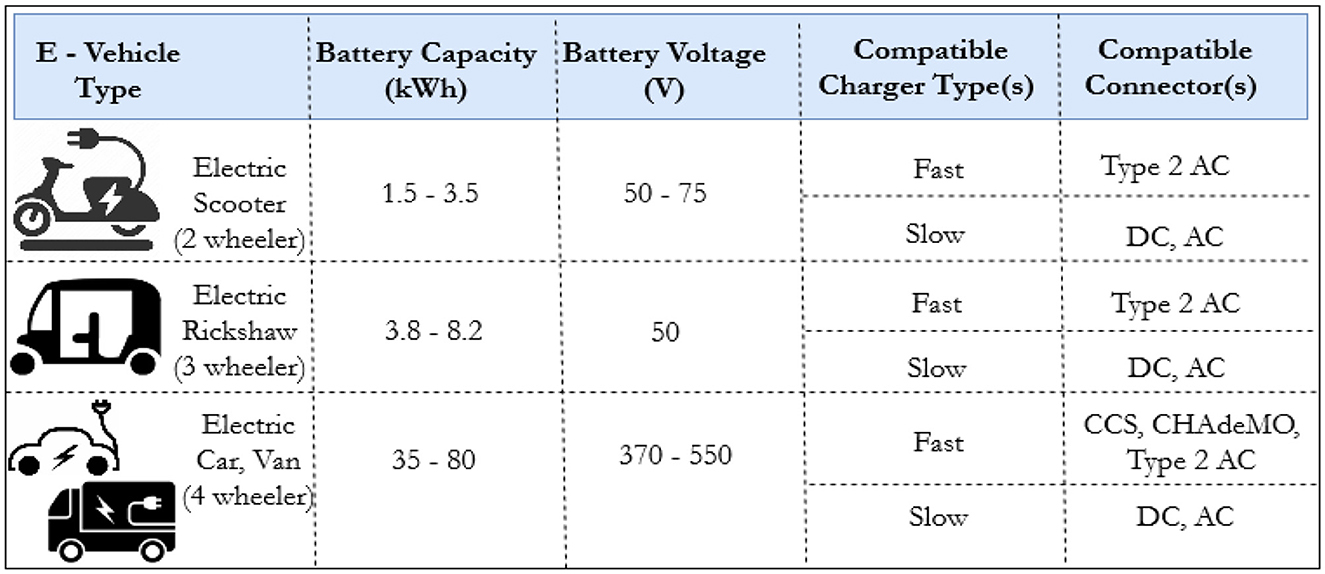
Figure 4. Basic categories of EVs and their specifications and compatible requirements adopted worldwide.
High fuel prices are another matter of concern, increasing proportionately with the increase in the usage of ICE vehicles (Singh et al., 2022). The most reliable, practically useful as well as feasible solution to the above–addressed issues is the replacement of the traditional ICE vehicles with fully electrified EVs, as they do not directly emit CO2 and also are less susceptible to issues like increased fuel prices. Thus, the advent of EVs can be justified to enhance the social and economic benefits in the transportation as well as energy sectors.
Another type of EV is the hybrid EV (HEV) which is the combination of ICE and the electric motor. The combination can be made either in series or in parallel. HEVs are more advantageous than EVs because of some of the added advantages like better fuel efficiency, less emissions, with minimal operational cost. Another technology used by HEVs is regenerative braking, which helps in recycling energy by storing energy in the battery while braking. The placement of a rechargeable battery, motor, ICE, and fuel tank in aplug–in hybrid electric vehicle (PHEV) and an EV is shown in Figure 5.
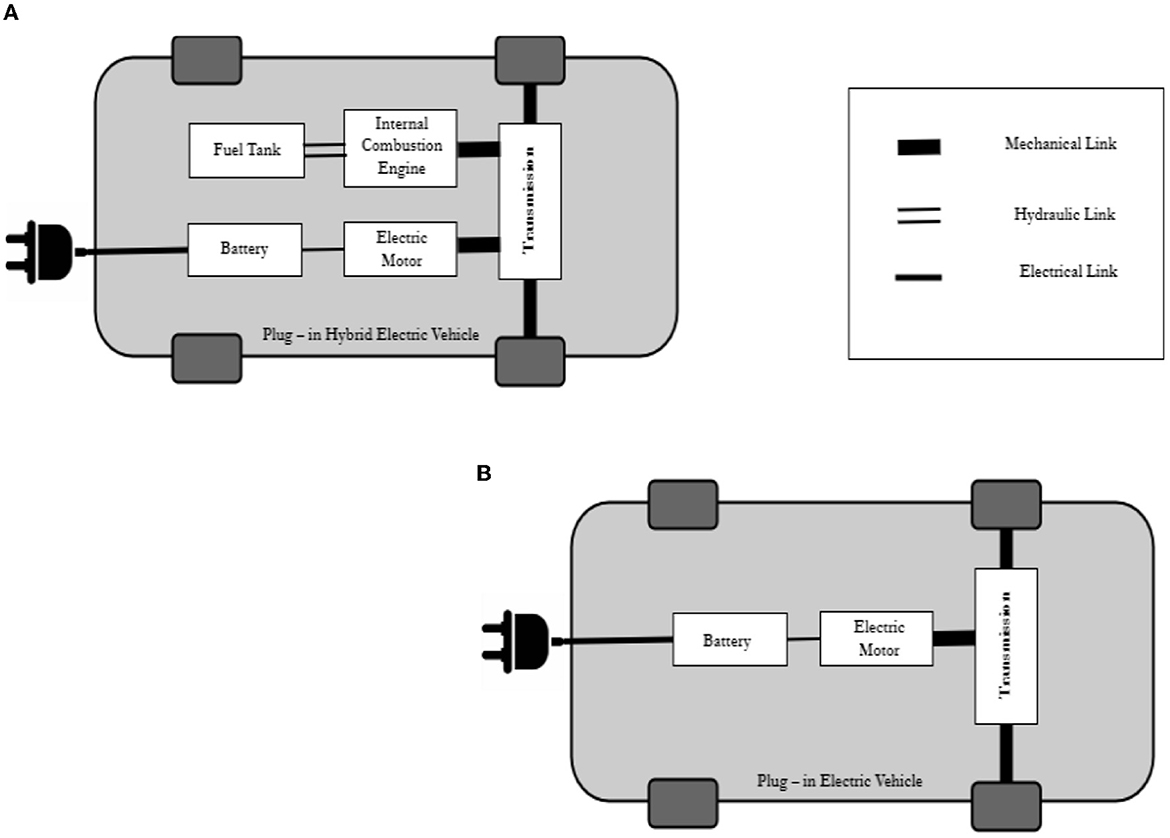
Figure 5. Components of plug–in electric vehicles: (A) hybrid electric vehicle; (B) basic battery–battery-operated electric vehicle.
In a hybrid type of plug–in EV, the user has the choice of using the vehicle either as an EV or as an ICE vehicle. In case of any issue like unavailability of EVSE, long–distance travels through remote routes, etc., the user of the vehicle can switch to the other alternative mode of driving the vehicle (Barragán-Moreno et al., 2022). The basic BEV, on the other hand, can be operated as a battery–operated EV only. The battery used in an EV is of rechargeable type, with a capacity typically between 35 and 80 kWh and a voltage range of 370–550 V depending on the model of the EV. An electric car has the advantage of being able to be charged by any type of charger available.
Sustainable charging for EVs needs to be implemented as far as possible as an everyday practice, e.g., Balacco et al. (2021) have proposed a new way of charging EVs sustainably by utilizing the excess water pressure of Pumps used as Turbines (PATs), and providing a sustainable means of electricity generation to be utilized to charge the EVs. Table 1 enlists the advantages and disadvantages of various types of charging systems available for charging EV batteries.

Table 1. Advantages and disadvantages of various types of EV charging systems (Vaidya and Mouftah, 2020; Urooj et al., 2021; Barragán-Moreno et al., 2022; Ko et al., 2022).
Vaidya and Mouftah (2020) have proposed an architecture that helps in managing the charging plans for EVs traveling on the road. An algorithm is used where EV drivers find optimal charging requirements using a simulation of an application thereby reducing their travel time. An application design has been put to use to minimize the trip time of EVs by guaranteeing charging stations for them during their journey.
The present state–of–art regarding the identified problem can be explained as a result of the extensive background study undertaken for this manuscript. Analysis of the battery capacity, degradation detection, and end—life of the–ion batteries of EVs based on the energy calibration via correlation (ECC) method and adaptive Kalman filter (AKF) are covered in Barragán-Moreno et al. (2022). Other important parameters, namely, State–of–Health (SoH) and State-of-Charge (SoC) have been estimated with the use of machine learning and electrochemical impedance spectroscopy (EIS) data (Google Trends, 2023) and Double Kalman Filter (Aswani et al., 2018) respectively. Solar PV is an efficient and convenient mode of generating–grid electricity sustainably (Singh et al., 2022), and the PV generator works in multi-pinned phase (MPP) mode and the power flow between the storage and end users is enabled by the storage unit (Barragán-Moreno et al., 2022). An open hardware platform that is freely downloadable for the custom testing of the BMS is proposed in Jiang and Zhen (2019). The expenses incurred in the EV charging infrastructures on highways are estimated using a highway corridor model (Vaidya and Mouftah, 2020). The minimization of the expenses incurred in a smart charging station along with maintaining the quality of service (QoS) for the EV users has been proposed in Urooj et al. (2021). The excess water pressure in water distribution networks (WDNs) is utilized by the PATs to generate energy sustainably for charging the EVs as well as reduce water pressure thus avoiding water leaks (Balacco et al., 2021). Ko et al. (2022) focus on using EV batteries as distributed energy storage using fuzzy control techniques. Another way of improving the on–the–run efficiency of EVs is by finding optimal charging requirements and minimizing their travel time (Rienzo et al., 2022). The route planning and charging problem has again been addressed in Hivziefendic et al. (2022) which minimizes the traveling time, cost, energy consumption, distance to travel, and cost minimization while considering the state of charge (SoC) of the BEVs. A method of a reliable and systematic EVSE location evaluation system using five indices of grid electricity load, traffic facilities, user preference, construction cost, and service radius is presented in Khaksari et al. (2021), Ben Abbes et al. (2022), and Bryła et al. (2023). An IoT–based setup is employed in simulation to check the battery charge in EVs in outdoor conditions (Barragán-Moreno et al., 2022). An in–detail analysis of the impact of EV charging station loads on the users, the locations of the charging facilities, and the economic losses due to various causes is done by Zhao et al. (2019). An on–demand valet charging mode, with the economic and business advantages of marketing, advertisements, technological integration, etc., is proposed to fully utilize the underutilized public charging infrastructure thus motivating the end users to own and use EVs (Yang et al., 2021). Three types of electric recharging stations for EVs are proposed by Li et al. (2019), namely: fast charging station, slow charging station, and battery swap station. An optimized charging model including thedemand–supply constraint has been proposed by Deb et al. (2018). The parking areas when embedded with EV charging facilities, that too use renewable energy sources, become an added advantage to the already existing systems. This facility, when scheduled for optimizing the charging schedule for EVs using PV systems as well as ESS is, implemented by Xu et al. (2020). Another way of optimizing the EV charging expenses is by restricting the charging process only to when the electricity charges are minimal. Adata–driven approach is proposed in Alabri and Jayaweera (2022), where machine learning models are trained with a dataset comprising processes from a workplace. An analysis of the impact of smart charging on the battery health of EV batteries is conducted by Zu and Sun (2022).
Despite having many advantages, several prominent factors are restricting the acceptance of EVs in India, namely, the cost of EVs, the time taken to recharge the EV battery, expenses incurred in doing so, and the location of charging facilities. Table 2 summarizes the various classes of factors that are restricting the adoption of EVs in India.
The charging infrastructure industry in India is at a nascent stage (Urooj et al., 2021). While maintaining the QoS, the sizing issue of any charging station, concerning the number and types of chargers, is one of the basic prerequisites to focus upon while working on any charging infrastructure (Ko et al., 2022). The availability of a smart and intelligent EV charging facility is an evolving scenario where electricity prices, SoC of batteries, weather conditions, andreal–time traffic, all are fluctuating whereas the charging tasks are to be accomplished within a stipulated time. Vehicle-to-vehicle (V2V) may be considered an innovative way to accomplish these criteria (Khaksari et al., 2021; Hivziefendic et al., 2022).
3 Materials and methods
Figure 6 shows the original picture of a charging station in Haryana, India.
The dataset is created for EVSEs present in the states and union territories of India. Fields considered in the dataset are States and Union Territories, Address of the Charging Facility, Zip Code, Type of Facility, Charger Location, Number of Chargers, Number of Ports, Charger Level, and Manufacturer Name. The total number of entries in the dataset is 261 in India, consisting of a total of 27 Indian States and Union Territories.
A generalized architecture of smart charging systems for EVs is depicted in Figure 7. Each charging station is equipped with several various types of chargers and ports. The information regarding the availability and distance of charging stations needs to be analyzed by the cloud and informed to the EV users so that they have the convenience to decide and plan their travel routes (Frendo et al., 2020; He et al., 2022). The real–time data regarding the use and availability of chargers is analyzed in the cloud and the EV user is intimated of the status along with the distance of the charging station from the current location of the EV (Frendo et al., 2020). A local database may be used to store temporary or intermediate data. The billing and the calculation of the charging expenses can be done with the help of a charging meter attached to the system (Frendo et al., 2020). The electricity generation source required for EVSE can be a central or decentralized form of sustainable energy, such as solar, hydroelectric, wind, etc. (Rienzo et al., 2022). The form of energy to be used for charging the EVs must also be analyzed efficiently to reduce the use of grid energy, and charging expenses and enhance environmental sustainability.
Various types of charger levels of EV chargers have been denoted in Table 3.

Table 3. Charger levels of EV chargers (Jiang and Zhen, 2019; Frendo et al., 2020; Khaksari et al., 2021).
CCS connectors and CHAdeMO are different because CCS is more universal—they can offer AC/DC charging from the same port, whilst CHAdeMO requires an extra connector to do this. Without the adapter, CHAdeMO is not compatible with Type 1 and Type 2 charging.
Thus, in response to RQ. 1, Table 3 is generated to depict the number of EV charging stations in each state and union territory of India. RQ. 3 can be addressed by analyzing Table 4. The state having the highest number of EV charging stations in India is Telangana and Tripura is the state with the least number of EV charging stations.
According to the generated dataset, a map of India is depicted in Figure 8 showing the states highlighted with the darker shades have a greater number of EV charging stations, and those with a smaller number of EV charging stations are marked with lighter shades.
4 Results and discussions
The obtained results after analysis of the dataset are presented in this section. The analysis is done concerning 22 states and five union territories of India, where EV charging stations are established.
4.1 Number of EV charging stations in every state and union territory of India
Figure 9 shows a sunburst of Indian states showing the number of charging stations in each state and union territory of India. The Indian state with the least number of EV charging stations is Chhattisgarh, with only two charging stations and the state with the highest number of charging stations in India is Telangana, with a total of thirty–three EV charging stations.
4.2 Number of EV charging stations in every type of charging facility
Various facilities have EV charging stations installed in their area. The facilities with installed EV charging stations in India are hotels, marketplaces, societies, restaurants, garages, EV stores, charging stations, etc. Figure 10 is a plot of the number of EV chargers in each of the facilities. It can be said that EV servicing workshop parking areas are the facilities in India that are found to have the maximum number of EV chargers, and a metro station is a facility which is having the least number of EV chargers. In response to RQ. 2, it is found that EV servicing workshop parking is the facility that is leading in having the maximum number of EV charging stations in India.
4.3 Density and number of EV chargers in each state of India
The tree map in Figure 11 shows the density of EV chargers in each state and union territory of India. although the number of EV charging stations is maximum in Telangana, the number of EV chargers is found the most in Haryana followed by Telangana. Whereas Tripura contains the least number of EV chargers.
The plot of the number of EV charging stations is depicted in Figure 12. The maximum number of EV chargers in India is in Haryana with a total of 62 chargers, followed by Telangana with a total of 60 EV chargers. Whereas the minimum number of EV chargers is found in Tripura, with only one charger.
4.4 Number of each type of EV charger in each state and union territory of India
In response to RQ. 4, it can be answered that the maximum number of Level 1 chargers is found in Telangana, that of Level 2 chargers is found in Maharashtra and the maximum number of Level 3 chargers is in Telangana. Whereas the minimum number of Level 1 chargers is found in Tripura, the minimum number of Level 2 chargers is in Odisha, Tripura, Uttarakhand, Puducherry, Dadra and Nagar Haveli, and Daman and Diu and that of Level 3 chargers are found in Uttar Pradesh, Himachal Pradesh, Assam, Bihar, Chhattisgarh, Punjab, and Jammu and Kashmir, Ladakh, Dadra and Nagar Haveli and Daman and Diu.
The plot in Figure 13 shows a plot of all levels of chargers in each of the states and union territories of India.
Table 5 shows the states where there is the maximum and minimum number of each of Levels 1, 2, and 3 chargers.
4.5 Most popular EV charger manufacturers in India
Figure 14 shows the most popular EV charger manufacturers in India. The most popular EV charger manufacturer in India is Tata Motors with a total of 62 EV chargers installed in different regions of India and the least popular ones are Ztric Ltd., Urjasva Energy, EV Zest, and Tesla with a meager number of 2 EV chargers installed across India. This serves as the response to RQ. 5.
5 Conclusions
In conclusion, the comprehensive review of EVCS in India showcases the potential for a cleaner, greener, and more sustainable form of mobility. Enhancing the establishment and use of charging facilities and their infrastructure in turn promoted the purchase and use of EVs, thus benefitting in multiple ways of reducing environmental footprint at affordable prices. Government incentives also play a major role in bringing about the EV revolution in any nation, regardless of hurdles like battery technology, initial investment expenses, etc.
There are numerous EV charging stations established in various states and union territories of India. This can be seen as an effort to enhance the purchase and use of EVs in the country. It can be seen that out of 28 states and eight union territories, only 22 states and five union territories have EV charging stations installed in them. Telangana, Haryana, and Maharashtra are the states having the largest number of charging stations, the states like Odisha, Chhattisgarh, and Tripura are lagging in having the number of EV charging stations. Among the union territories, Delhi is leading in the number of EV charging stations, whereas Jammu and Kashmir has only one. Other union territories, such as Lakshadweep, Andaman, and Nicobar Islands are still to implement EV charging stations.
To ensure the enhanced use of EVs in India, the planning and management of the EV charging stations have to be endured and implemented by the government. Sustainability can be further ensured by promoting renewable energy sources to reduce the grid electricity usage and thus taking another step forward toward a sustainable environment. Thus, the planning of installation of EV charging stations can be done in coordination with the availability of solar, hydroelectric, wind, biomass, geothermal, etc. energy sources along with the network of roads in the country.
Author contributions
YG: Conceptualization, Data curation, Formal analysis, Funding acquisition, Investigation, Methodology, Project administration, Resources, Software, Supervision, Validation, Visualization, Writing – original draft, Writing – review & editing. MD: Conceptualization, Data curation, Formal analysis, Investigation, Methodology, Software, Supervision, Validation, Writing – original draft, Writing – review & editing. DG: Conceptualization, Data curation, Formal analysis, Investigation, Methodology, Project administration, Software, Supervision, Validation, Writing – original draft, Writing – review & editing. SJ: Conceptualization, Data curation, Formal analysis, Investigation, Methodology, Software, Supervision, Validation, Writing – review & editing. AS: Conceptualization, Methodology, Writing – review & editing. MM: Conceptualization, Methodology, Writing – review & editing.
Funding
The author(s) declare financial support was received for the research, authorship, and/or publication of this article. This work was supported by the Deanship of Scientific Research, Vice Presidency for Graduate Studies and Scientific Research, King Faisal University, Saudi Arabia, under Project grant 5,265.
Conflict of interest
The authors declare that the research was conducted in the absence of any commercial or financial relationships that could be construed as a potential conflict of interest.
Publisher's note
All claims expressed in this article are solely those of the authors and do not necessarily represent those of their affiliated organizations, or those of the publisher, the editors and the reviewers. Any product that may be evaluated in this article, or claim that may be made by its manufacturer, is not guaranteed or endorsed by the publisher.
References
Alabri, W., and Jayaweera, D. (2022). Optimal coordination of unbalanced power distribution systems with integrated photovoltaic systems and semi-fast electric vehicles charging stations. IET Generat. Transm. Distrib. 16, 2399–2415. doi: 10.1049/gtd2.12458
Aswani, G., Bhadoria, V. S., and Singh, J. (2018). “Electric vehicles in india: opportunities and challenges,” in Proceedings of International Conference on Automation and Computational Engineering (ICACE) (Greater Noida: IEEE), 65–71.
Balacco, G., Binetti, M., Caggiani, L., and Ottomanelli, M. (2021). A novel distributed system of E-vehicle charging stations based on pumps as turbine to support sustainable micromobility. Sustainability 13, 1847. doi: 10.3390/su13041847
Barragán-Moreno, A., Schaltz, E., Gismero, A., and Stroe, D. I. (2022). Capacity state-of-health estimation of electric vehicle batteries using machine learning and impedance measurements. Electronics 11, 1414. doi: 10.3390/electronics11091414
Ben Abbes, S., Rejeb, L., and Baati, L. (2022). Route planning for electric vehicles. IET Intellig. Transp. Syst. 16, 875–889. doi: 10.1049/itr2.12182
Bryła, P., Chatterjee, S., and Ciabiada-Bryła, B. (2023). Consumer adoption of electric vehicles: a systematic literature review. Energies 16, 205. doi: 10.3390/en16010205
Chakraborty Parker, R., Hoque, T., Cruz, J., Du, L., Wang, S., et al. (2022). Addressing the range anxiety of battery electric vehicles with charging en route. Sci. Rep. 12, 5588. doi: 10.1038/s41598-022-08942-2
Deb, S., Tammi, K., and Kalita, K. (2018). Impact of electric vehicle charging station load on distribution network. Energies 11, 178. doi: 10.3390/en11010178
El-Fedany, I., Kiouach, D., and Alaoui, R. (2019). Application design aiming to minimize drivers' trip duration through intermediate charging at public station deployed in smart cities. World Electr. Veh. J. 10, 67. doi: 10.3390/wevj10040067
Frendo, O., Graf, J., Gaertner, N., and Stuckenschmidt, H. (2020). Data-driven smart charging for heterogeneous electric vehicle fleets. Energy and AI 1, 100007. doi: 10.1016/j.egyai.2020.100007
Google Trends (2023). Available online at: https://trends.google.com/trends/explore?date=today%205-yandgeo=INandq=electric%20vehicles (accessed 20 January, 2023).
He, S. Y., Kuo, Y. H., and Sun, K. K. (2022). The spatial planning of public electric vehicle charging infrastructure in a high-density city using a contextualised location-allocation model. Transp. Res. Part A: Policy Pract. 160, 21–44. doi: 10.1016/j.tra.2022.02.012
Hivziefendic, J., Vuic, L., Lale, S., and Saric, M. (2022). Application of the voltage control technique and MPPT of stand-alone PV system with storage. Adv. Elect. Comp. Eng. 22, 21–30. doi: 10.4316/AECE.2022.01003
Jiang, W., and Zhen, Y. (2019). A real-time EV charging scheduling for parking lots with PV system and energy store system. IEEE Access 7, 86184–86193. doi: 10.1109/ACCESS.2019.2925559
Khaksari, A., Tsaousoglou, G., Makris, P., Steriotis, K., Efthymiopoulos, N., and Varvarigos, E. (2021). Sizing of electric vehicle charging stations with smart charging capabilities and quality of service requirements. Sust. Cities Soc. 70, 102872. doi: 10.1016/j.scs.2021.102872
Ko, Y., Cho, K., Kim, M., and Choi, W. (2022). A novel capacity estimation method for the lithium batteries using the enhanced coulomb counting method with kalman filtering. IEEE Access 10, 38793–38801. doi: 10.1109/ACCESS.2022.3165639
Lei, X., He, J., Fan, L., and Wang, G. (2022). Active equalization strategy for lithium-ion battery packs based on multilayer dual interleaved inductor circuits in electric vehicles. J. Adv. Transportat. 2022, 8653547. doi: 10.1155/2022/8653547
Li, Q., Xiao, Y., Zhao, S., Zhu, X., Wang, Z., Liu, Z., et al. (2019). Performance status evaluation of an electric vehicle charging infrastructure based on the fuzzy comprehensive evaluation method. World Electr. Veh. J. 10, 35. doi: 10.3390/wevj10020035
Macioszek, E. (2021). “The role of incentive programs in promoting the purchase of electric cars-review of good practices and promoting methods from the world,” in Research Methods in Modern Urban Transportation Systems and Networks. Lecture Notes in Networks and Systems, Vol. 207, eds E. Macioszek and G. Sierpiński (Cham: Springer).
Macioszek, E., and Sierpiński, G. (2020). “Charging stations for electric vehicles-current situation in Poland,” in Research and the Future of Telematics: 20th International Conference on Transport Systems Telematics, TST 2020 Kraków, Poland (Cham: Springer International Publishing). 124–137.
Rienzo, R. D., Verani, R., Baronti, A., Roncella, F., and Saletti, R. (2022). Modular Battery emulator for development and functional testing of battery management systems: the cell emulator. Electronics 11, 1215. doi: 10.3390/electronics11081215
Savio Abraham, D., Verma, R., Kanagaraj, L., Giri Thulasi Raman, S. R., Rajamanickam, N., Chokkalingam, B., et al. (2021). Electric vehicles charging stations' architectures, criteria, power converters, and control strategies in microgrids. Electronics 10, 1895. doi: 10.3390/electronics10161895
Singh, A., Shaha, S. S., Sekhar, Y. R., Saboor, S., and Ghosh, A. (2022). Design and analysis of a solar-powered electric vehicle charging station for Indian cities. World Electr. Veh. J. 12, 132. doi: 10.3390/wevj12030132
Suomalainen, E., and Colet, F. (2019). A corridor-based approach to estimating the costs of electric vehicle charging infrastructure on highways. World Electr. Veh. J. 10, 68. doi: 10.3390/wevj10040068
Urooj, S., Alrowais, F., Teekaraman, Y., Manoharan, H., and Kuppusamy, R. (2021). IoT based electric vehicle application using boosting algorithm for smart cities. Energies 14, 1072. doi: 10.3390/en14041072
Vaidya, B., and Mouftah, H. T. (2020). Smart electric vehicle charging management for smart cities. IET Smart Citi. 2, 4–13. doi: 10.1049/iet-smc.2019.0076
Xu, Y., Hu, M., Zhou, A., Li, Y., Li, S., Fu, C., et al. (2020). State of charge estimation for lithium-ion batteries based on adaptive dual Kalman filter. Appl. Math. Model. 77. 1255–1272. doi: 10.1016/j.apm.2019.09.011
Yang, L., Cheng, Z., Zhang, B., and Ma, F. (2021). Electric vehicle charging station location decision analysis for a two-stage optimization model based on shapley function. J. Mathemat. 2021, 5098378. doi: 10.1155/2021/5098378
Zhao, Y., Huang, H., Chen, X., Zhang, B., Zhang, Y., Jin, Y., et al. (2019). Charging load allocation strategy of EV charging station considering charging mode. World Electr. Veh. J. 10, 47. doi: 10.3390/wevj10020047
Keywords: electric vehicle, batteries, sustainable, cleaner fuels, electric vehicle charging stations
Citation: Gulzar Y, Dutta M, Gupta D, Juneja S, Soomro AB and Mir MS (2024) Revolutionizing mobility: a comprehensive review of electric vehicles charging stations in India. Front. Sustain. Cities 6:1346731. doi: 10.3389/frsc.2024.1346731
Received: 29 November 2023; Accepted: 12 January 2024;
Published: 01 February 2024.
Edited by:
Dharmendra Singh Rajput, VIT University, IndiaReviewed by:
Richard Kotter, Northumbria University, United KingdomElżbieta Macioszek, Silesian University of Technology, Poland
Copyright © 2024 Gulzar, Dutta, Gupta, Juneja, Soomro and Mir. This is an open-access article distributed under the terms of the Creative Commons Attribution License (CC BY). The use, distribution or reproduction in other forums is permitted, provided the original author(s) and the copyright owner(s) are credited and that the original publication in this journal is cited, in accordance with accepted academic practice. No use, distribution or reproduction is permitted which does not comply with these terms.
*Correspondence: Yonis Gulzar, eWd1bHphckBrZnUuZWR1LnNh; Sapna Juneja, c2FwbmFqdW5lamExOTgzQGdtYWlsLmNvbQ==
 Yonis Gulzar
Yonis Gulzar Monica Dutta
Monica Dutta Deepali Gupta
Deepali Gupta Sapna Juneja
Sapna Juneja Arjumand Bano Soomro1,4
Arjumand Bano Soomro1,4